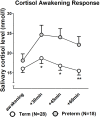Postpartal Affective and Endocrine Differences Between Parents of Preterm and Full-Term Infants
- PMID: 32296356
- PMCID: PMC7139630
- DOI: 10.3389/fpsyt.2020.00251
Postpartal Affective and Endocrine Differences Between Parents of Preterm and Full-Term Infants
Abstract
Background: During the postpartum period, new parents frequently experience emotional stress and exhibit symptoms of depression and anxiety, accompanied by substantial endocrine changes. However, evidence predominantly exists from parents of full-term infants, while data on parents of preterm infants are scarce. In this exploratory, cross-sectional study, we compared psychological well-being and endocrine parameters in parents of very preterm and term born infants.
Methods: Mothers (N = 28) and fathers (N = 30) of full-term infants as well as mothers (N = 18) and fathers (N = 21) of very or extreme preterm infants (< 32nd gestational week) were recruited in the days following birth. Anxiety, depression, and perceived stress were assessed with the State-Trait Anxiety Inventory (STAI), the Beck Depression Inventory (BDI), and the Perceived Stress Questionnaire (PSQ), respectively. Physiological measures included serum levels of estradiol, progesterone, prolactin, and thyroid-stimulating hormone (mothers only), as well as the salivary cortisol awakening response (mothers and fathers).
Results: New mothers and fathers of very preterm infants exhibited higher scores of depression, anxiety and stress than parents of term infants. Besides, mothers of very preterm infants showed lower levels of estradiol, progesterone, and prolactin, as well as a heightened post-awakening cortisol response compared to mothers of term infants. Furthermore, in mothers of preterm infants we found significant negative associations between serum prolactin levels and BDI and STAI scores, respectively.
Conclusions: Parents of very preterm infants suffered from a higher burden of psychological distress than parents of full-term infants. The affective symptoms in preterm mothers were accompanied by altered endocrine profiles that, at least to some extent, may contribute to the psychological changes. The profound psychological and physiological disturbances in mothers of preterm infants may have an impact on long-term mental health and early pharmacological and psychological interventions may help to ameliorate postpartum affective symptoms.
Keywords: anxiety; cortisol; depression; ovarian hormones; postpartum; preterm birth.
Copyright © 2020 Weigl, Schneider, Stein, Felderhoff-Müser, Schedlowski and Engler.
Figures





References
LinkOut - more resources
Full Text Sources
Medical

